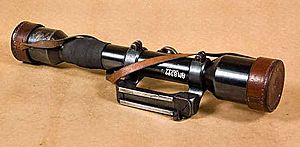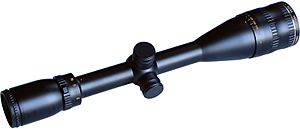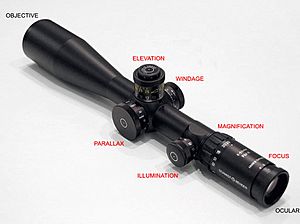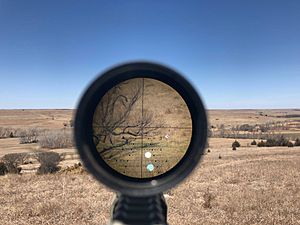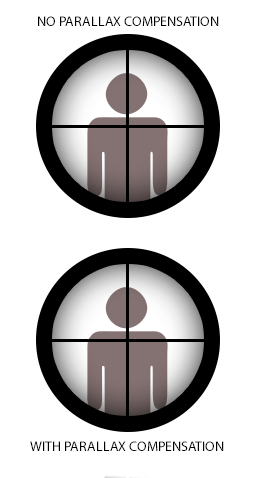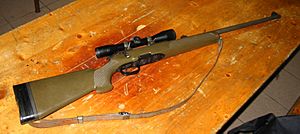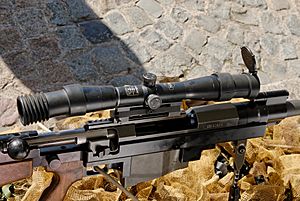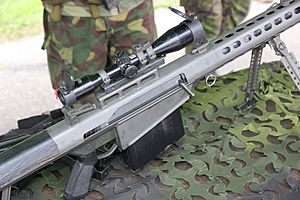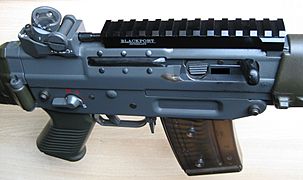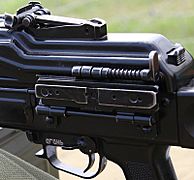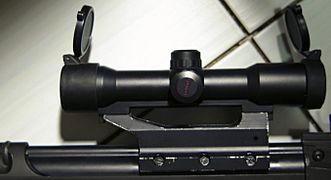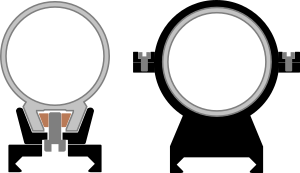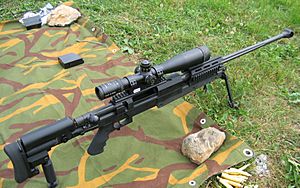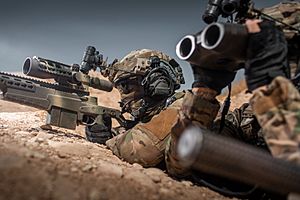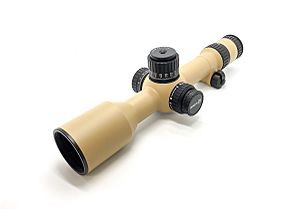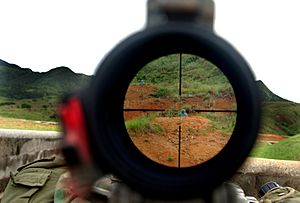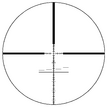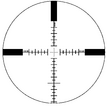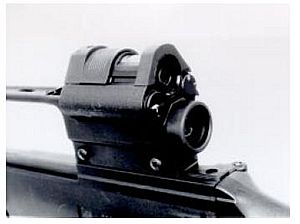Telescopic sight facts for kids
A telescopic sight, often just called a scope, is a special optical device that helps you aim. It's like a small refracting telescope with a special aiming pattern inside called a reticle. This pattern helps you aim very accurately.
Scopes are used on many things that need a clear, magnified view for aiming. They are most common on long-barrel firearms, especially rifles, and are attached using a scope mount. You can also find similar devices on Artillery, Tanks, and even Aircraft. Some modern scopes even have night vision or smart features!
Contents
How Did Telescopic Sights Start?
People started trying to use optical devices to help with aiming way back in the early 1600s. For a long time, these early versions had problems.
One interesting story is about William Gascoigne, an English astronomer, in the 1630s. He was looking through a Keplerian telescope and found a spider had spun a web inside. When he looked through it, the web was in focus with distant objects! Gascoigne realized he could use this idea to make a scope for his astronomy work.
In 1776, Charles Willson Peale and David Rittenhouse tried to put a telescope on a rifle. But it was hard to place it far enough forward so that the eyepiece wouldn't hit the shooter's eye when the gun kicked back (called recoil).
The first real rifle scope was invented between 1835 and 1840. A gunsmith named Morgan James in New York made them based on ideas from John R. Chapman. Later, in 1855, William Malcolm started making his own scopes. These scopes used special lenses and had better ways to adjust for wind and height. Malcolm's scopes were very popular during the American Civil War.
An early scope for seeing in low light or at night was the Zielgerät 1229, also known as Vampir ("vampire"). It was an active infrared night vision device used by the German army in World War II on the StG 44 assault rifle. It was used a little bit in combat starting in 1945.
Different Kinds of Scopes
Scopes are usually described by their optical magnification (how much they zoom in) and the size of their objective lens (the front lens). For example, "10×50" means it zooms in 10 times, and the front lens is 50 mm wide. A bigger front lens lets in more light, making the image brighter.
Most old scopes had a fixed zoom level. Later, scopes with variable zoom appeared. You could change the zoom by turning a ring. Variable-power scopes are more flexible for different distances, target sizes, and light conditions. They are written like "3-9×40", meaning the zoom can go from 3 times to 9 times, and the front lens is 40 mm.
Prism Scopes
A newer type of scope is called a prismatic telescopic sight or prism scope. Instead of many lenses, it uses a roof prism (like in binoculars) to make the image upright. The aiming pattern (reticle) is etched onto one of the prisms, which makes it easy to light up the reticle. Prism scopes can also help people with astigmatism see clearly.
Prism scopes are lighter and smaller than regular scopes. They usually have a fixed, low magnification (like 2×, 3×, or 4×), which is good for short to medium distances. A famous example is the Trijicon ACOG, used by the USMC.
LPVOs: Low-Power Variable Optics
Scopes with a variable zoom in the low range (like 1–4×, 1–6×, or 1–8×) are called low-power variable optics or LPVOs. These scopes often have a lighted reticle and can zoom down to 1× (no zoom). Since they are used for close and medium distances, LPVOs usually don't have parallax compensation. They are very popular for modern sporting rifles.
Scope Features and What They Mean
Scopes are designed for specific uses, and their features reflect that.
Optical Details
- Magnification – This is how much the scope zooms in. A 10× scope makes things look 10 times closer. Higher magnification means a smaller field of view (you see less area).
- Objective lens diameter – This is the size of the front lens, usually in millimeters. A larger lens gathers more light, making the image brighter.
- Field of view – This is how much area you can see through the scope. It's often given as how many meters wide you see at 100 meters.
- Exit pupil – This is the circle of light you see when you look through the eyepiece. For the brightest image, this circle should be about the same size as your eye's pupil (about 7 mm for young people in the dark). A larger exit pupil makes it easier to quickly find the image.
- Eye relief – This is the distance you need to hold your eye from the eyepiece to see the full image. Longer eye relief (like 100 mm) is good to prevent the scope from hitting your eye during recoil (when the gun kicks back). It's also helpful for people who wear eyeglasses.
Lens Coatings
Scopes have many lenses, and manufacturers put special coatings on them. These coatings help more light pass through, reduce reflections, and make the image clearer and brighter. They can also protect the lenses from scratches, water, and grease.
- Anti-reflective coatings reduce light that gets lost by reflecting off the lens surfaces. This makes the image brighter and less hazy. A good coated scope can give a brighter image than an uncoated one with a larger lens!
Tube Size
The main tube of a scope varies in size. Common sizes are 1 inch (25.4 mm), 30 mm, and 34 mm. A larger tube allows for more space inside for lenses and adjustments, and can make the scope stronger. Scopes for long-range or low-light use often have larger tubes.
How to Adjust Your Scope
Scopes have several knobs or rings to adjust them:
- Diopter adjustment (on the eyepiece) – This helps you get a sharp view of the target and the reticle.
- Elevation control – This moves the aiming point up or down. You use it to adjust for how far the bullet drops over distance.
- Windage control – This moves the aiming point left or right. You use it to adjust for wind.
- Magnification control – On variable scopes, this changes the zoom level.
- Reticle illumination control – This adjusts how bright the lighted aiming pattern is.
- Parallax compensation control – This makes sure the target and the reticle are in the same focus plane.
The elevation and windage knobs often make a clicking sound as you turn them. Each "click" moves the aiming point by a small, set amount. Common click values are 0.1 mil (about 10 mm at 100 meters) or 1/4 MOA (about 1/4 inch at 100 yards).
Aiming Patterns (Reticles)
Scopes come with many different reticles. These patterns can be simple or very complex. They help you aim, estimate distances, and even adjust for bullet drop and wind.
There are two main types of reticles:
- Wire reticles are older and made of thin metal wire.
- Etched reticles are made by etching a pattern onto a glass plate. Etched reticles stay fully black and clear even when lit from behind.
Reticle Designs
Reticle patterns can be as simple as a dot, a small cross, or a circle. Most reticles have both horizontal and vertical lines for better aiming.
Crosshairs
The crosshair is the simplest reticle, with two lines crossing in the middle. The center is where you aim. Some crosshairs have thicker outer sections, called duplex reticles. These help you aim in low light and can even be used for rough distance estimates if you know the size of your target.
Milling Reticles
Many modern reticles are designed for rangefinding. The most popular is the mil-dot reticle, which has small dots (or hash marks, called mil-hash reticles) along the crosshairs. These are called "milling reticles".
Mil-based reticles are popular because they work well with the metric units system. One milliradian (mil) at 1000 meters is exactly 1 meter. So, if you know a target's size, you can easily calculate its distance using a simple formula: "[Target size] ÷ [Number of mil intervals] × 1000 = Distance". For example, if a 1.8 meter tall object looks 3 mils tall in your scope, it's 600 meters away (1.8 ÷ 3 × 1000 = 600).
Holdover Reticles
Some milling reticles have extra markings, often dots or lines, in the bottom part. These are called holdover reticles. They help you adjust for bullet drop and wind drift without having to turn the scope's adjustment knobs. You just aim a little higher or to the side using the marks on the reticle.
These reticles often look like a Christmas tree because they get wider at the bottom to help with aiming at longer distances. Famous examples include the Horus TReMoR and Vortex EBR-2B.
Reticle Focal Plane
Scopes have two places where the reticle can be put:
- First Focal Plane (FFP) – The reticle is placed before the zoom lenses. This means the reticle appears to grow and shrink with the target as you change the magnification. This is good for rangefinding because the measurements on the reticle stay accurate at any zoom level.
- Second Focal Plane (SFP) – The reticle is placed after the zoom lenses. This means the reticle always looks the same size to you, no matter the magnification. If you use a rangefinding reticle, it will only be accurate at one specific magnification (usually the highest). Most modern variable-power scopes are SFP unless they say otherwise.
FFP scopes are generally more expensive and it can be tricky to design a reticle that is easy to see at both low and high magnifications.
Reticle Illumination
Many reticles can be illuminated (lit up) for use in low light or even during the day. It's important that you can adjust the brightness. If it's too bright, it can make it harder to see in the dark.
Illumination usually comes from a battery-powered LED. Red is a common color because it doesn't hurt your night vision as much. Some scopes use tritium (a radioactive material) or fiber optics to light up the reticle without batteries.
Extra Features
Bullet Drop Compensation (BDC)
Bullet drop compensation (BDC) is a feature on some scopes that helps you adjust for how much a bullet drops over distance. It has special markings on the reticle or the elevation knob for different distances. This helps you aim correctly without having to do complex math.
BDC is usually set for a specific type of bullet and gun. It's great for quick aiming at medium to long ranges, but it might not be perfect if the weather or other conditions are very different from what it was set for.
Parallax Compensation
Parallax happens when the target image and the reticle are not perfectly in the same focus plane inside the scope. If your eye moves even a little, the reticle might seem to "float" or move over the target. This can cause you to aim incorrectly.
To fix this, some scopes have parallax compensation. This moves a lens inside the scope to make the target and reticle perfectly aligned. There are two main ways to adjust for parallax:
- Adjustable Objective (AO) – You turn a ring on the front (objective) lens of the scope.
- Side Focus (SF) – You turn a knob on the side of the scope. This is often preferred because it's easier to reach.
Most scopes don't have parallax compensation because it adds to the cost, and for many uses, it's not strictly needed. These scopes are usually set to be "parallax-free" at a common distance, like 100 meters for hunting scopes. Scopes for airguns, which are used at very short distances, almost always have parallax compensation because errors are more noticeable up close.
Scope Accessories
Here are some common accessories for scopes:
- Lens hood – A tube that attaches to the front or back of the scope to block sunlight and reduce glare. An eyecup on the eyepiece can also protect your eye from recoil.
- Lens covers or lens caps – These protect the lenses from dirt, weather, and damage.
- Optical filters – Like grey or yellow filters, to improve image quality in different light.
- Anti-reflection device (ARD) or KillFlash – A honeycomb-like cover on the front lens that stops reflections, which could give away your position.
- Scope cover – A soft pouch that protects the whole scope during travel or storage.
Smart Scope Technology
Built-in Laser Rangefinders
Some modern scopes have a laser rangefinder built right in! This lets you measure the distance to your target with the push of a button.
Ballistic Support Systems
Some very advanced scopes have a small computer built in, like the BORS system by Barrett. You tell it what kind of ammunition you're using, and it automatically calculates the right elevation for the distance, considering things like air density and how the rifle is tilted. This helps you make very accurate shots at long distances.
Digital Displays and Cameras
Newer scopes can have a clear digital screen inside the eyepiece. This screen can show you information from a computer, like distance or wind, right on top of the optical image. Some "smart scopes" even use a video camera to capture and display a digital image of the target. They can have built-in rangefinders, ballistic calculators, and even connect wirelessly to other devices. Some can even use infrared to help you see in low light or total darkness.
Mounting Your Scope
Most firearms don't come with a scope already attached. So, you need extra parts to put a scope on your gun. A typical setup has two parts: scope rings and a scope base. The goal is to mount the scope straight over the gun's barrel.
Scope Rings
Scopes have a round main tube, so they are usually attached with scope rings. These are round metal clamps that hold the scope firmly. Most often, two rings are used for strength. The rings must fit the scope's tube size perfectly. Common ring sizes are 1 inch, 30 mm, and 34 mm.
Scope Bases
The scope base is the part on the rifle's body (called the receiver) where the scope rings attach. Older guns might have screw holes directly on the receiver. A popular design is the dovetail rail, which is a metal bar with a special shape. Scope rings slide onto this rail.
The most common mounting systems today are the Weaver rails, the Picatinny rail, and the NATO Accessory Rail. These rails provide a standardized way to attach scopes and other accessories.
Mounting Rails
Some European scope makers offer scopes with special mounting rails built into the bottom of the scope. These rails mean you don't need separate scope rings. The rail makes the scope very strong and reliable, even with heavy recoil.
Rail Interface Systems
Rail interface systems are standardized ways to attach scopes and other accessories to guns.
- The Picatinny rail is a very common standard, used by NATO forces. It has a T-shape with evenly spaced slots.
- The older Weaver rail is similar but has slightly different dimensions. Most Picatinny accessories will fit on Weaver rails, but not always the other way around.
- The NATO Accessory Rail (NAR) is a newer, metric version of the Picatinny rail. They are very similar and mostly work with each other.
Mounting Challenges
Scopes on guns with heavy recoil (like powerful rifles) or spring piston airguns (which have a "reverse recoil") can sometimes experience scope creep. This is when the scope slowly moves backward in its rings. To prevent this, the rings must fit perfectly and be tightened very carefully. If rings are not aligned or tightened correctly, they can damage the scope.
Another challenge is mounting a scope on a rifle that ejects empty shells from the top. Sometimes the scope has to be offset to the side to allow the shells to clear.
Adjustable Mounts
Some mounts can also be adjusted. This is useful for very short-range or very long-range shooting, where the bullet drop is so big that the scope's own adjustments might not be enough. Adjustable mounts allow the scope to work in the middle of its adjustment range, which is better for the scope's internal parts.
Why Use a Scope?
Scopes have pros and cons compared to iron sights (the simple sights on a gun). With iron sights, you have to focus on the front sight, the target, and the rear sight all at once, which can be hard. Scopes let you focus on both the aiming pattern (reticle) and the target at the same time, because the lenses project the reticle into the distance. This makes the target clearer and easier to see.
The main downside of scopes is that the higher the magnification, the less area you can see around your target. Scopes are also more expensive and can be more fragile than iron sights.
Military Use
For a long time, scopes were mostly used by snipers in the military because they were expensive and could break easily. But since the 1980s, scopes have become more common for regular soldiers. Scopes help soldiers hit targets more accurately, especially in dim light, and at longer distances.
However, scopes can also have disadvantages for soldiers. Sunlight can reflect off the lens, which might give away a sniper's hidden position. Also, scopes can be less tough than iron sights in very harsh weather.
Many modern armies now give scopes to their regular infantry. For example, the U.S. military uses the Advanced Combat Optical Gunsight (ACOG) on their M16 rifles and M4 carbines. The British army uses the SUSAT scope, and the Canadian Forces use the Elcan C79. Some German rifles even have a built-in dual sighting system with both a scope and a red dot sight.
The Israeli military started using scopes widely for their regular soldiers to improve accuracy. Even in conflicts like the al Aqsa Intifada, militants found that adding a cheap scope to their rifles made them more effective.
See also
 In Spanish: Mira telescópica para niños
In Spanish: Mira telescópica para niños
- Picatinny rail


